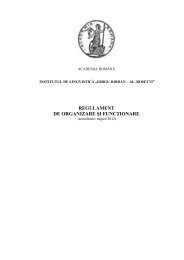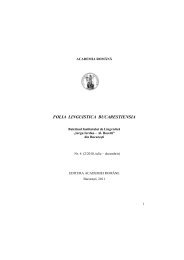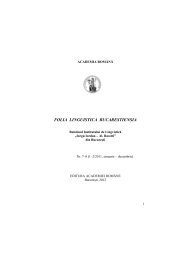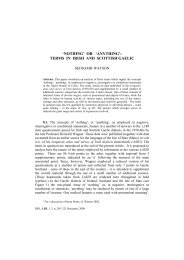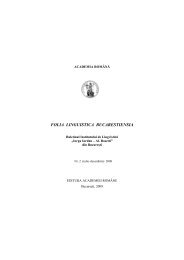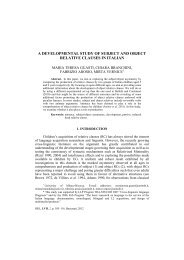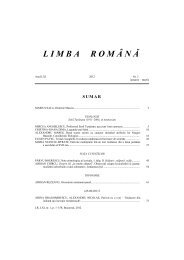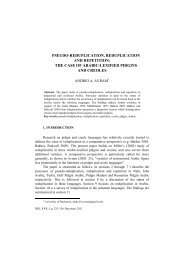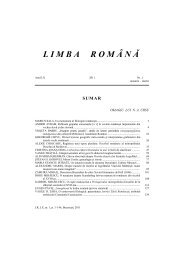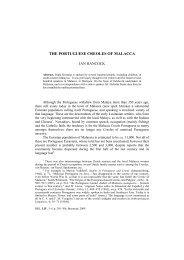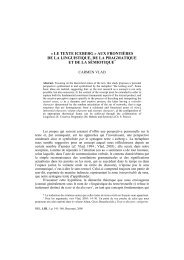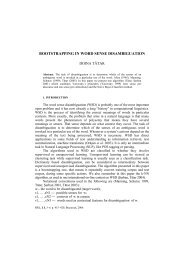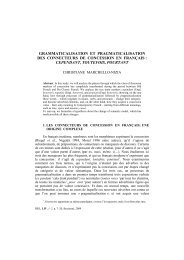GABRIELA PANÄ DINDELEGAN (coord.), Limba românÄ â Aspecte ...
GABRIELA PANÄ DINDELEGAN (coord.), Limba românÄ â Aspecte ...
GABRIELA PANÄ DINDELEGAN (coord.), Limba românÄ â Aspecte ...
- No tags were found...
Create successful ePaper yourself
Turn your PDF publications into a flip-book with our unique Google optimized e-Paper software.
518Comptes rendus 12references are rather present at the beginning of the chapter, but they gradually seem to disappear.From the point of view of the terminology, mixed traditional, structuralist, generative, cognitive termsare used. A first classification is made related to the number of arguments a verb can take (0-placepredicates, 1-place predicates and so on). Further, the author defines each theta-role (very useful forthe dictionary at the end of the book), assigning semantic features to it, in order to obtain well-formedsentences.The last part of Elena Consantinovici’s book is a practical dictionary containing the semanticand syntactic organisational scheme of different categories of verbs (previously theoreticallydescribed). The author starts from alphabetically raging the infinitive forms of the selected verbs;then, their meaning is explained (for polysemantic verbs, the main specific meanings are detailed).Further on, the argument structure is presented, together with examples. At the end, the syntacticstructure of the verb is shown. The dictionary is mostly useful for students learning Romanian as aforeign language (but also for students of linguistics, who have troubles with verbal theta-grids), sinceit gives the most common contexts a verb can combine with.To sum up with, Elena Constantinovici’s The Semantics and Morphosyntax of Verb inRomanian is a useful theoretical tool. Even though the (international) bibliographical material is notthoroughly explained and has not been entirely updated, this book presents the morphological,syntactic, semantic and partly pragmatic features (and also combinations of such features) Romanianverbs have. The fact that it was published outside Romania contributes to the value of the book,because it is very scientifically interesting to see how Romanian is perceived by a native Romanianspeaker not within Romania’s territory. Of course, it is worth mentioning that E. Constantinovici hasused to a great extent Romanian bibliography (also the latest Romanian Academy’s Grammar). Thedictionary at the end is a very useful tool, especially for students.Ionuţ GeanăInstitut of Linguistics “Iorgu Iordan – Al. Rosetti”, BucharestCHRISTIANE MARCHELLO-NIZIA, Grammaticalisation et changementlinguistique, De Boeck, Bruxelles, 2006, 300p.Les enjeux linguistiques et cognitifs à l’œuvre dans le processus de grammaticalisationexpliquent l’intérêt marqué pour ce type de changement, surtout après la remise à l’honneur de lalinguistique diachronique. Le livre de Christiane Marchello-Nizia réalise une mise en perspective dece processus, en essayant de le circonscrire à la fois de l’intérieur, à travers la problématisation desacquis théoriques et une proposition de modélisation du phénomène, et de l’extérieur, au sein d’unetypologie des changements linguistiques.La division du livre reflète un choix méthodologique qui vise à rétrécir le champ d’analyse àmesure que l’auteur fait ressortir du contact avec le corpus les insuffisances de l’approche théorique,ce qui lui permet de relancer le débat sur une autre base. Cette démarche analytique et critique aboutitainsi à un infléchissement de la problématique vers une conception systémique qui se réclame deBenveniste, Coşeriu et, dans une moindre mesure, de la grammaire générative.A partir du constat de l’ambivalence du terme de grammaticalisation – type de changementmais aussi approche théorique –, le premier chapitre se propose d’appréhender le phénomène dansune perspective fonctionnelle, sémantique et cognitive en faisant découvrir les présupposésthéoriques, les étapes, les facteurs et les régularités à l’œuvre dans ce processus. « Processus dechangement dynamique et unidirectionnel, par lequel des mots lexicaux ou des constructionssyntaxiques acquièrent un statut de forme grammaticale » (p. 16), la grammaticalisation se laisseanalyser au plan sémantique par la réinterprétation, au plan syntaxique par la réanalyse etmorphologique par une recatégorisation. Phénomène de synthèse, foncièrement complexe, elle exige



